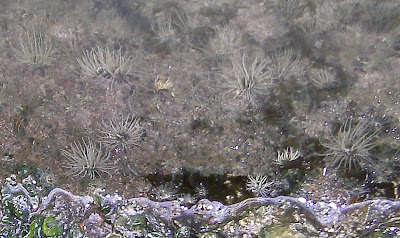Sea stars are not usually seen on the floating docks, but this summer when I visited the marina at low tide, the docks had lowered on the pilings to the upper subtidal zone. On my last visit, I encountered several sea stars crawling over marine life on the pilings. From the morphology, coloration of the madreporite, and size, they appeared to be Asterias forbesi.
Sea stars prey on mussels and other species on the pilings and harbor floor. When feeding on a mussel, the sea star attaches its tube feet to each shell and exerts force to separate them slightly. A tug of war ensues, and only a small gap is sufficient for the sea star to insert a fold of its stomach and start digesting the body. When the mussel is sufficiently digested, the sea star brings its stomach back into its body with the food inside. The sea star has a well-developed sense of smell and can detect the odor of mussels and crawl towards them.
Sea stars are able to move around via a water vascular system of tube feet that act as suction cups to walk over the surface or pull prey into the mouth. The tube feet are located on the ventral surface and the water intake structure, called a madreporite, is located on the dorsal surface.
Docks and Pilings at MacMillan Wharf
Docks slide up and down on the pilings as the tide rises and lowers about 10 feet. Permanent growth of most algae and invertebrates can only be sustained below the low tide line.
Sea Star Near the Water Line of a MacMillan Wharf Piling
The center of the sea star is raised up as though it is feeding on a prey, or it is about to feed on the mussel wedged between two arms. When the sea star was lifted, it was not feeding on another meal, so perhaps is was headed towards the mussel.
Dorsal Surface of the Sea Star Asterias forbesi
Dorsal Surface of the Sea Star Asterias forbesi
Dorsal surface of the same Asterias showing the red madreporite and numerous spines covering the arms.
Sea Star Righting Itself after Being Place on its Ventral Surface
Sea stars can rapidly right themselves by flipping over using their tube feet and flexible bodies. This photo was taken 1-2 minutes after the photo above.
LINKS:
Echinoblog: Feeding: What and How do Starfish Eat.
Global Biodiversity Information Facility: GBIF.ORG: Asterias forbesi (Desor, 1848)



























































